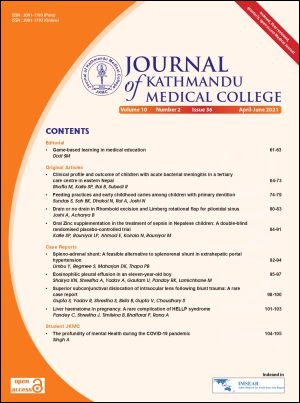Drain or no drain in Rhomboid excision and Limberg rotational flap for pilonidal sinus
DOI:
https://doi.org/10.3126/jkmc.v10i2.40018Keywords:
Pilonidal sinus, Rhomboid Flap, Wound infectionAbstract
Background: Healing in Rhomboid flap for pilonidal sinus is always a problem. Different measures are applied to reduce the rate of wound infection with variable results.
Objectives: To determine the effect of routine use of drain on the rate of early wound complications and additional interventions after Rhomboid flap.
Methods: A retrospective chart review of all cases that underwent Rhomboid flap in five years in two tertiary care centres was done. Complication rates such as wound infection, wound disruption, and flap necrosis were evaluated.
Results: A total of 38 cases of Rhomboid flap are included for analysis. Out of all cases 37 cases were done for Pilonidal sinus and one case for presacral dermoid cyst. In the first eight cases, flap was made without drain and subsequent 30 cases were done with two suction drains for five days. The rate of superficial wound infection in the group without drain was found to be significantly higher compared with flap with drain 5 (in 8) versus 2 (in 30) (62.5% versus 6.66%, p <0.5).
Conclusion: Drain placement after Rhomboid flap is a good intervention to reduce wound infection.
Downloads
Downloads
Published
How to Cite
Issue
Section
License
Copyright © Journal of Kathmandu Medical College
The ideas and opinions expressed by authors or articles summarized, quoted, or published in full text in this journal represent only the opinions of the authors and do not necessarily reflect the official policy of Journal of Kathmandu Medical College or the institute with which the author(s) is/are affiliated, unless so specified.
Authors convey all copyright ownership, including any and all rights incidental thereto, exclusively to JKMC, in the event that such work is published by JKMC. JKMC shall own the work, including 1) copyright; 2) the right to grant permission to republish the article in whole or in part, with or without fee; 3) the right to produce preprints or reprints and translate into languages other than English for sale or free distribution; and 4) the right to republish the work in a collection of articles in any other mechanical or electronic format.




